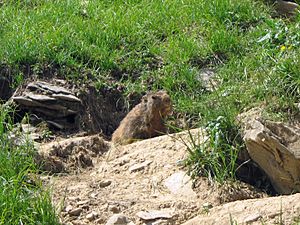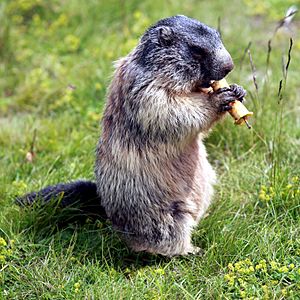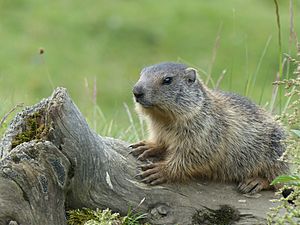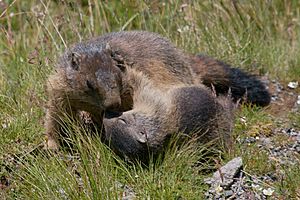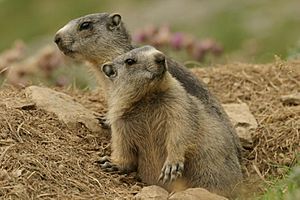Alpine marmot facts for kids
Quick facts for kids Alpine Marmot |
|
|---|---|
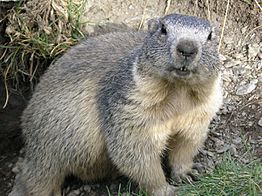 |
|
| An Alpine marmot in the regional park of the Queyras in France | |
| Conservation status | |
| Scientific classification | |
| Kingdom: | |
| Phylum: | |
| Class: | |
| Order: | |
| Family: | |
| Genus: | |
| Species: |
M. marmota
|
| Binomial name | |
| Marmota marmota (Linnaeus, 1758)
|
|
The Alpine marmot is a type of marmot, which is a large rodent (like a big squirrel). You can find them in the mountains of central and southern Europe. They are the third-biggest rodent in Europe. Only the Eurasian beaver and the Crested porcupine are larger.
Alpine marmots grow up when they are about three years old. They live in family groups, sometimes with up to twenty marmots together. These marmots have lived in the mountains since the ice age. Today, they mostly live in higher mountain areas.
Alpine marmots live at heights between 800 and 3,200 meters (about 2,600 to 10,500 feet). They are found in the Alps, Carpathians, Tatras, Pyrenees, and Northern Apennines in Italy. They were brought back to the Pyrenees in 1948. They had disappeared from there a long time ago.
They are amazing diggers. They can dig through soil that even a pickaxe would find hard. They also spend up to nine months each year in hibernation.
Contents
What Does an Alpine Marmot Look Like?
An adult Alpine marmot can stand about 18 cm (7 inches) tall at the shoulder. They are usually between 42 and 54 cm (16.5 to 21 inches) long. This length does not include their tail, which is about 13 to 16 cm (5 to 6 inches) long.
Their weight changes a lot during the year. In spring, after hibernation, they weigh about 2.8 to 3.3 kg (6 to 7 pounds). But in fall, before winter, they can weigh much more, from 5.5 to 8 kg (12 to 17.5 pounds). This is because they eat a lot to store fat.
The Alpine marmot is sometimes called the largest squirrel species. However, a close relative, the hoary marmot, can sometimes be heavier. Their fur is a mix of blonde, reddish, and dark gray colors. Most of their fingers have claws, but their thumbs have nails, just like humans.
Where Do Alpine Marmots Live?
As their name suggests, Alpine marmots live all over the European Alps. You can find them in the mountain areas of France, Italy, Switzerland, Germany, Slovenia, and Austria. They have also been moved to other places. These include the Pyrenees, France's Massif Central, Jura, Vosges, Black Forest, Apennine Mountains, and the Romanian Carpathians.
There are many marmots in their main living areas. For example, in the Romanian Carpathians, there are about 1,500 marmots. Alpine marmots like alpine meadows and high-up pastures. Here, their groups live in deep burrow systems. These burrows are often in sandy soil or rocky places.
Marmots sometimes lie on flat rocks, which looks like "sun bathing." But scientists think they are actually trying to cool down. This might also help them get rid of parasites. Marmots are sensitive to temperature. If it gets too warm, they can lose their homes, which affects the whole species.
What Do Alpine Marmots Eat?
Alpine marmots eat different kinds of plants. They like grasses and herbs. They also eat grain, insects, spiders, and worms. They prefer young and soft plants the most. They hold their food with their front paws while they eat.
They usually come out of their burrows to eat in the morning and afternoon. They do not like heat very much. On very warm days, they might not eat at all. When the weather is good, they eat a lot of food. This helps them build up a layer of fat on their bodies. This fat helps them survive their long hibernation period.
How Do Alpine Marmots Live?
When Alpine marmots dig a burrow, they use both their front and back paws. Their front paws scrape away the soil. Then their back paws push the soil out of the way. If there are any stones in the way, they will remove them with their teeth. This works as long as the stones are not too big.
They make "living areas" at the end of a burrow. These areas are often lined with dried hay, grass, and plant stems. Other tunnels that do not lead anywhere are used as toilet areas. Once a burrow is finished, only one family lives there. But the next generation often makes the burrow bigger. Over time, this can create very complex burrow systems.
Each Alpine marmot lives in a group with several burrows. This group has a main breeding pair. Alpine marmots protect their territory. They will warn off intruders by beating their tail and chattering their teeth. They also mark their area with their scent.
You can often see an Alpine marmot "standing up." They do this to look out for dangers like predators. When they see danger, they make loud whistle sounds. After the warning, other marmots in the group will run for cover.
Reproduction and Life Cycle
Alpine marmots mate in the spring. This happens right after they finish their hibernation. This timing gives their offspring the best chance to store enough fat to survive the next winter. Alpine marmots can start to breed when they are two years old.
Once the female is pregnant, she brings soft materials like grass into the burrow. She uses this for when she gives birth. The gestation period is about 33 to 34 days. Each litter usually has three babies, but it can be anywhere from one to seven.
The babies are born blind. Their fur will grow dark within a few days. The mother feeds them milk for about forty days. During this time, she leaves the young in the burrow while she finds food. After this period, the babies come out of the burrow. They start to look for solid food themselves.
By the end of the summer, their fur becomes the same color as other Alpine marmots. After two years, they reach their full size. If they live in captivity, Alpine marmots can live for 15 to 18 years.
Hibernation Habits
As summer ends, Alpine marmots gather old plant stems in their burrows. They use these as bedding for their long hibernation. This sleep can start as early as October. They seal their burrow with a mix of earth and their own poop.
Once winter arrives, Alpine marmots huddle close together. Then they begin their hibernation. During this time, their heart rate slows down to only five beats per minute. Their breathing also slows to just 1 to 3 breaths per minute. This slow rate helps them use their stored fat very slowly. This usually allows them to survive the winter. However, some younger marmots might starve if their fat runs out.
Alpine Marmots and Humans
In the past, Alpine marmots were hunted a lot. People believed that their fat could help with rheumatism when rubbed on the skin. They were also hunted for food. Hunting of the Alpine marmot still happens today, both for sport and for their fat. Hunting is not a danger to the species as a whole, as long as it is controlled. This is because they do not breed very quickly.
Overall, the Alpine marmot is not currently in danger of disappearing. However, some smaller groups of marmots might be threatened. This includes those in the Jura and in Germany. There is also a very small group in Rodna that is threatened by illegal hunting.
Images for kids
-
A family tree showing how different rodents are related
See also
 In Spanish: Marmota alpina para niños
In Spanish: Marmota alpina para niños



